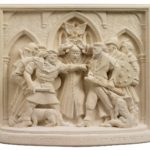The Market Cross
The Market Cross
by D. D. Dixon
During the middle ages, when weekly markets and statute fairs were of greater importance than they are in these days, the village cross or the market cross was the centre of the whole commerce of the district. From its steps royal pronouncements were given.
When in 1291 Robert FitzRoger obtained from King Edward 1 a charter for a weekly market to be held on Thursdays and a fair yearly, on the eve, day and morrow of Saint Matthew the Apostle, within his manor of Rothbury, whether there was then a market cross or not we have no record, and it is not until so late as the beginning of the 18th century that we have any certain account of Rothbury Market Cross. We must however bear in mind that during the commonwealth period anything in the form of, or bearing the name of a cross, was held in great abhorrence by our Puritan forefathers, who destroyed many of our fine old Market Crosses. Therefore, when Rothbury Parish Council was denuded of its ornaments ( as we know it was) during that unfortunate period, the older cross may have shared in a general despoliation.
The Rothbury Market Cross of which we are accustomed to speak was erected in 1722 by several of the then influential inhabitants of the village, to afford shelter to the country folks when attending their weekly market with their produce – butter, eggs, poultry etc. It was a square building with a hipped roof, and had four open sides, round arched, very similar to the one at Stamfordham. About the beginning of the present century the cross was in so ruinous a condition that it was considered dangerous. Therefor in 1827, instead of having it restored, the freeholders had the building entirely pulled down and every stone of it removed. Luckily, however, a person who evidently had a little of the antiquary in his composition, got the mason – for half a gallon of ale,- to carry a stone containing the inscription into his garden. This stone is yet in existence. [?]
It is said that the Duke of Northumberland ( Lord of the Manor), who then came to Rothbury every year on his way to Kielder Castle and luncheoned at the “Three Half Moons” was so much annoyed at the destruction that he gave up visiting Rothbury altogether and journeyed to his shooting box in North Tyne by another route. There was a great to do about it amongst the villagers and the vandals who had been instrumental in its destruction were threatened with legal proceeding’s. An old woman composed a long doggerel rhyme in memory of the cross; there is neither poetry nor beauty in its composition, but it is valuable in preserving a record of the cross and of its destruction as well as the names of several old families in Rothbury. The following three verses below are thought sufficient;- Ye ancient inhabitants mourn for the loss
Of that venerable pile, I mean Rothbury Cross
Where oft in my childhood I happy did play
With youthful companions long since away
There was the Grahams and the Milburns the Storers and Storeys
The Clennells the Snawdons the Todds and the Dores
The Matthews and Mavins – thats just half a score
Believe me, dear neighbours, there is a few more.
If the age of the cross you are wishful to know
To the “Black Bull” yard I ask you to go.
Where with letters inserted, conspicuous to view
Is seventeen hundred and twenty-two.
Urged by the query in the Weekly Chronicle of November 24th 1888, respecting Rothbury Market Cross, and acting upon the advice given in the last verse, I went to the “Black Bull” yard, and found the tablet mentioned, built into the gable end of a house the property of Mr John Clark. The only name legible is that of “Archibald Douglas” an ancestor of the querist in the Weekly Chronicle, Christopher Douglas of West Hartlepool. The others may have been Robert Snowdon and Robert Readhead both of whom were men of note in the parish at that time (1722).
A few of the inhabitants of Rothbury can remember the ruins of the cross and a very old man informed me that he could recollect, when as a boy, watching the countrymen go to the cross when trying on the leather breeches they were about to buy at the October fair. He also informed me of the price of salt and tobacco at that time (90 to 100 years ago) He said that when a Pig was killed – a great event in the country his mother sent him to Philip Nairn, a shopkeeper in Rothbury for a “staen I’saat an a yerd I’baccy.” The salt cost 5s and the tobacco one penny.
Near to the cross, the pillory was wont to be erected and not far off stood the village stocks whilst about twenty yards to the west lay the Rothbury Bull ring described to me by an old Rothburian who knew the spot well as being “ a fearful big staen flag wi a greet iron ring in’t as thick as yor airm” [ a very big flat stone with a big iron ring in it as thigh as your arm]
The village green or market place, an open space in the middle of the village, more commonly known as the “Cross” whereon the market cross stood, is now the rendezvous of all the travelling tinkers, besom-makers, muggers and gypsies that peregrinate the country, and who, without let or hindrance, encamp upon it, such being the right of an ancient village green.
Rothbury Parish Magazine March 1893
Transcribed by F.M.W.
